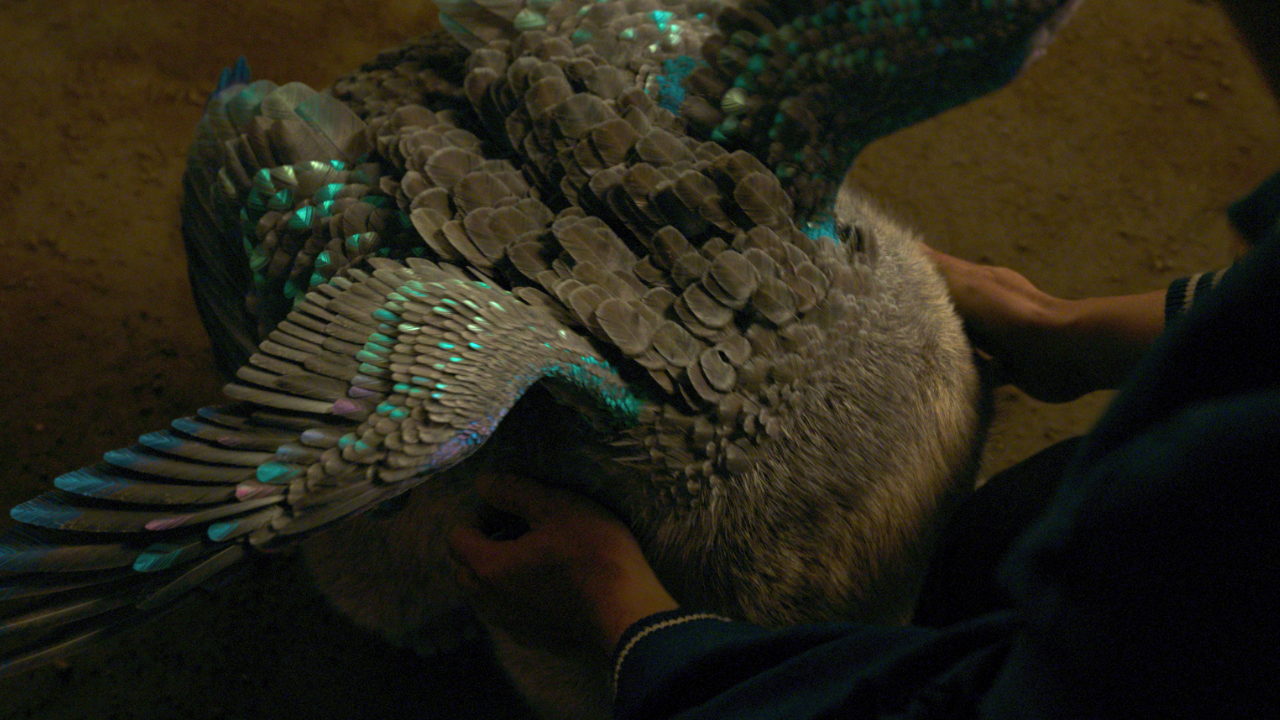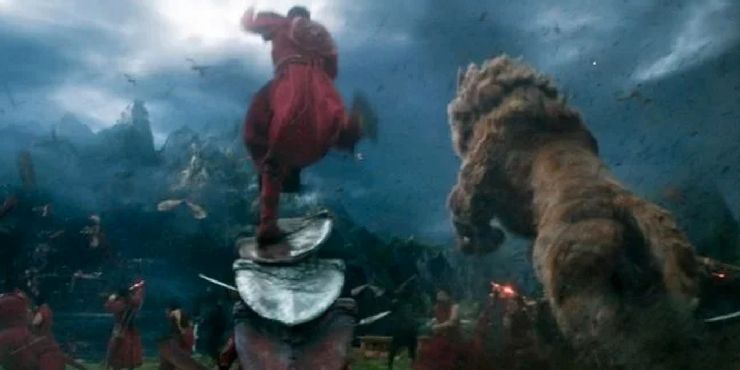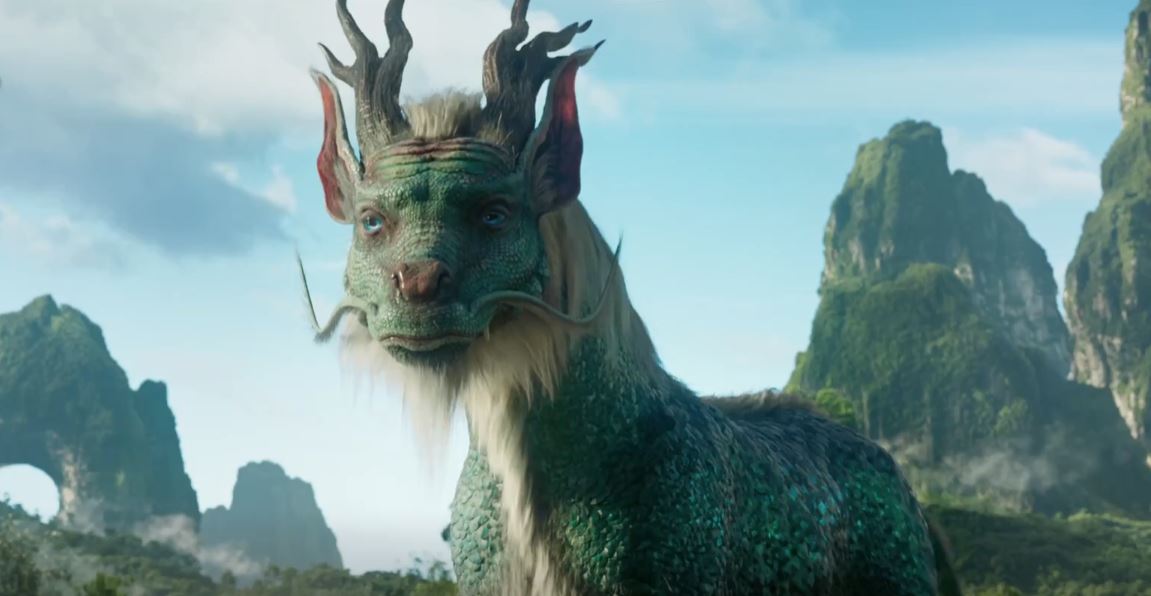Shang-Chi & the Legend of the Ten Rings is the second movie project in phase 4 of the MCU and also the first oriental martial arts work produced by Marvel Studios. Not only bringing new superheroes, this movie also cleverly connects with the multiverse idea that Marvel is ingeniously exploiting: That is the appearance of the land of Dai La (Ta Lo), “hometown” of two brothers Thuong Qi (Shang-Chi) and Ha Linh (Xialing).
Dai La is located in another dimension, surrounded and protected by a bamboo forest that is constantly moving so that no one can determine the direction or the way to this place. True to the main style of Shang-Chi & the Legend of the Ten Rings, Dai La offers a lot of exotic paintings inspired by Chinese folklore.
Emperor River/Chaos

The first strange creature that Shang-Chi and Katy discovered was Morris, inspired by Di Jiang, considered the embodiment of Chaos (Hundun) in Chinese culture. This creature has been recorded in documents since 400 BC, the most famous being the Son Hai Kinh, an ancient book that synthesizes myths as well as mystical creatures in Chinese history.
Over the centuries, the records of De Giang have also changed somewhat. However, the creature is often depicted as a dog, headless, hairy, six-legged (there are four-legged versions) and four-winged. Although the character building is very close to the above image, it seems that Morris in Shang-Chi is quite lovely and funny, not with the temperament of a chaotic god.
Phoenix

Appearing as soon as Shang-Chi’s group had just passed through the waterfall to reach Dai La, were two phoenixes fluttering against the deep blue sky. This is also the creature recorded in the Son Hai Kinh, considered the ruler of all birds and the ancestor of many other wild beasts. The Phoenix has existed for at least 8000 years in Chinese mythology, often as a symbol of life balance, luck or virtue.
In the past, “Phuong” was used to refer to the male bird, and “Hoang” to the female bird. By the Yuan Dynasty (1271 – 1368), these two words were frequently used together in a fixed cluster to refer to this noble bird, regardless of their gender. The phoenix is commonly found in the Kunlun Mountains in northern Tibet and has now become an important part of Chinese culture. Many motifs were inspired by them and were used to decorate royal clothes, porcelain, weddings.
In addition, the Phoenix is often placed next to the dragon to create a symbol for the balance between yin and yang. Each part of this bird’s body even has a different meaning: the head represents virtue, the wings are responsible, the spine is a symbol of uprightness, the belly is prestige and the compassion is benevolence.
Crystal Lake

The fox fox is a nine-tailed fox and has inspired many Chinese and international television and film productions. According to the records of the Son Hai Kinh, they usually occur in the mountains and valleys of Shandong province. Their cries are innocent and clear like babies, but they can eat people alive easily. This sutra also said that if people eat fox spirit, people will be immune to many toxins from insects.
Over time, foxes were described as mischievous spirits, a harbinger of fortune. In later versions of Son Hai Kinh, it is bringing a whole new perspective on this creature: They can transform into heavenly beauties or men with flowers and butterflies, depending on age. of them. When living for 1000 years, the fox spirit can become a fairy, although movies often portray them as devious characters and often use their beauty to cause harm.
Shishi

Thach Su are stone lions often used to decorate palaces and temples. Many documents show that Shishi began to creep into Chinese culture when lions appeared during the Han dynasty, through trade deals on the famous Silk Road connecting Asia with Europe. As Buddhism became more popular in China, the image of the lion was changed to mean the protector of the Dharma.
Later, Thach Su was considered a guardian of palaces, tombs and other sacred places. That is why their statues are often placed in front of the door in pairs, one male and one female. The male will show his authority by placing one foot on the sphere and showing off his sharp claws. Meanwhile, the female takes on the role of a solid rear and takes care of a lion cub on her back.
In Shang-Chi & the Legend of the Ten Rings, Shishi also comes in pairs and is tasked with protecting the land of Dai La from external threats.
Unicorn

Just when Shang-Chi, Katy, Xialing and Trevor Slattery thought they had seen all of the mystical creatures in Dai La, their car suddenly stopped to make way for a tall, “like” creature. like a strange horse” passed. It is actually the Unicorn, the oldest animal of all the species mentioned above.
The Unicorn first appeared in the book Zuo Zhuan, born in the 5th century BC. Legend has it that a pair of Unicorns once appeared in the garden of Emperor Xuanyuan in 2697 BC. Later, in turn, Emperor Wu of Han also caught one in 122 BC. It was those Unicorns that increased their status, establishing the role of emperor on par with the gods. The Unicorn is often considered a pet of the gods, often living in peaceful and pure places. They often herald the arrival of an extraordinary immortal, or a member of the royal family.
Dragon

Finally, it is impossible not to mention the most recognizable creature in Chinese mythology – it is the dragon, a symbol of authority and strength. In ancient culture in this country, dragons are even associated with divine power, as a symbol of the emperor – who is always considered the son of heaven.
In addition, in many ancient documents, dragons are associated with heaven and water, responsible for moving and arranging water bodies such as streams, rivers, waterfalls or the sea. Characters like Dragon King, a dragon in human-like form, are even responsible for calling the rain and wind, governing the year-round weather in various areas.
The dragon has been a symbol of power, virtue, wisdom, strength and fortune in China for thousands of years, at least since 6200 BC. Today, dragons still play an important role in the culture in this country, still appearing in nearly every aspect of daily life, from idioms to food or architecture. In Hong Kong, for example, many tall buildings are built with the Dragon Gate, where dragons fly through on their journey from the mountains to the sea, symbolizing prosperity and bringing good luck to that place.
According to CBR/ScreenRant
.
